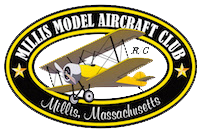Learn to Fly!
Flight Instruction
Radio Control Airplanes are a lot of fun. We are happy to provide Radio Control Airplane flight instruction to all club members. Many of our new pilots train on electric powered models that have become much more common in the .40 – .60 model size range, some will train on traditional glow powered aircraft. Many new members are also passionate about gliders, multi-prop copters, and helicopters. We can suggest a suitable flight instructor for any type of interest who can help train you on the style model of your choosing.
Today it is much easier than ever before to get started in this hobby. One can now visit their local hobby shop, you will find Links here, and along with great advice leave with your plane, transmitter and batteries all in one box. You will have to choose your power source either the ease of electric motors or the more traditional glow powered engines.
Some students learn quickly (a few weeks), but most will take a couple months to solo depending on how much training they are able to put in. Although it’s REALLY hard to estimate how much flight time it will take before you are able to solo, you should count on 50 fifteen minute flights to start. You can expect 2 to 6 flights a day on an average Saturday or Sunday. If you wish to learn to fly with us, get in touch with one our instructors so they can answer your questions and discuss the process. You can then meet at the field and begin learning how to get your gear into the air! Since our instructors are available at different times, you may need to contact two or more to find one who’s schedule matches yours.
Remember Two Things:
- Our instructors (below) are volunteers. Please respect that this is their hobby and they are here to have fun too!
- Your instructor may not be at the field every time you are. To avoid disappointments, please call to make arrangements EVERY time you plan to train since not all members at the field on a given day are instructors. Students are often helped by other instructors if their primary one is not available, but this other person may not know your skill level and where you are in the training process.
Your Plane and Radio
There are many different types of trainer planes, engines and radio systems available to the new pilot. A trip to a local hobby shop or an evening spent browsing on the Internet will probably create more questions than answers. We highly suggest meeting with an instructor at the field before you purchase anything. He can then not only speak about the equipment, but also actually show you. 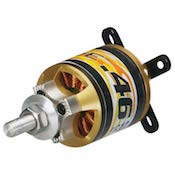 This way you can feel confident that the items you buy will be compatible with each other and appropriate for a novice.
This way you can feel confident that the items you buy will be compatible with each other and appropriate for a novice.
 Once you have purchased the gear, your instructor will be happy to answer your questions…but will encourage you to assemble the kit yourself. This is one way you can begin to understand the workings of a model aircraft. Once complete, however, you MUST have your aircraft & radio system checked by a flight instructor before you attempt to fly. Our experience says that 3 out of 4 new planes will need some additional work that should not be done at the field…due to either a mechanical or safety concern. It could be as simple as an uncharged battery or as dangerous as a cracked glue joint that went unnoticed. Virtually all of these issues can be fixed with a little time and effort. Unfortunately, the plane may not fly that day.
Once you have purchased the gear, your instructor will be happy to answer your questions…but will encourage you to assemble the kit yourself. This is one way you can begin to understand the workings of a model aircraft. Once complete, however, you MUST have your aircraft & radio system checked by a flight instructor before you attempt to fly. Our experience says that 3 out of 4 new planes will need some additional work that should not be done at the field…due to either a mechanical or safety concern. It could be as simple as an uncharged battery or as dangerous as a cracked glue joint that went unnoticed. Virtually all of these issues can be fixed with a little time and effort. Unfortunately, the plane may not fly that day.
One way to avoid disappointment is to take your plane 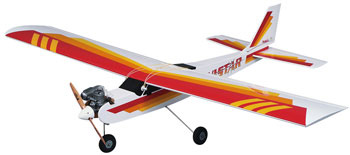 and radio to a club meeting and have it inspected there. You could also contact your instructor and arrange a time to have your plane checked prior to heading to the field. With a pre-inspected and “pre-fixed” plane, your first training day will be much more enjoyable!
and radio to a club meeting and have it inspected there. You could also contact your instructor and arrange a time to have your plane checked prior to heading to the field. With a pre-inspected and “pre-fixed” plane, your first training day will be much more enjoyable!
All our instructors prefer to utilize the “Buddy-Box” method to train their students. This tandem radio system allows you to hold a radio transmitter when flying, while at the same time, your instructor holds the 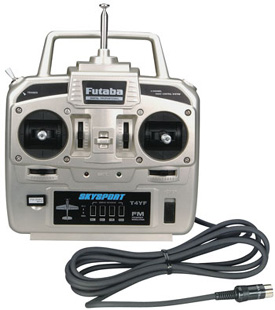 primary transmitter. If you experience difficulties your instructor can assume flight control with the flip of a switch. This saves the confusion caused by having to pass a single transmitter back and forth. The actual Buddy-Box is an almost empty transmitter that connects to the primary transmitter via a cable.
primary transmitter. If you experience difficulties your instructor can assume flight control with the flip of a switch. This saves the confusion caused by having to pass a single transmitter back and forth. The actual Buddy-Box is an almost empty transmitter that connects to the primary transmitter via a cable.
Although several instructors own Buddy-Boxes, we recommend that each student supply their own as it will help maintain the proper trim settings from session to session. Buddy-Boxes are available for around $50…much less than the cost of an airplane. Training with this method versus the the hand-it-back-and-forth method significantly adds to the pleasure of learning.
Field Equipment
Much like the process of choosing an aircraft and radio, selecting the proper support equipment can be overwhelming. Once again, look to your instructor for guidance. He can help you choose good quality, basic gear to get you started. Much of this equipmen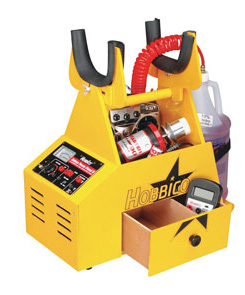 t will last you for forever…some will be replaced over time as it wears out or you discover personal preference for one item over another with experience. The important thing to remember is that you need only the basics to begin training.
t will last you for forever…some will be replaced over time as it wears out or you discover personal preference for one item over another with experience. The important thing to remember is that you need only the basics to begin training.
You will require fuel and pump, a electric starter and a glow ignitor for the glow engine or batteries and field charger for your electric motor, a restraint device to secure the plane when the engine is running as w ell as spare props and assorted tools. In addition, you will need an 12-volt battery to power some of these devices and a box of some sort to carry everything.
ell as spare props and assorted tools. In addition, you will need an 12-volt battery to power some of these devices and a box of some sort to carry everything.
All of your equipment can be purchased either at a local hobby shop or online. Also, rest assured that anything missing from your kit can be borrowed at the field as long as you remember to return the item when finished. Most of us can clearly remember our early days in the hobby and are willing to help a student in any way possible.
Flight Instructors
Your instructor may not be at the field every time you are. To avoid disappointments, please call to make arrangements EVERY time you plan to train since not all members at the field on a given day are instructors.
Students are often helped by other instructors if their primary one is not available, but this other person may not know your skill level and where you are in the training process.

John Holcomb
Chief Instructor
e-mail John Holcomb

John Nye
e-mail John Nye
